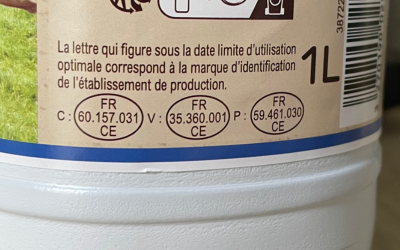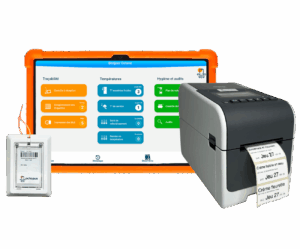Health stamp: what is it and how do I get it?
But how exactly do they work and why are they so important? If you are a food business, obtaining the health stamp can be a real asset for your activity. In this article, we will explain in detail what a health stamp is, how to obtain it, and what its benefits are.
What is a health stamp? ?️
Health stamps are official symbols affixed to food products that have been approved by the competent health authorities. These stamps are intended to guarantee food safety for consumers by certifying that the products comply with current health standards and their origin.
Official control services are responsible for issuing the health stamp, which allows identifying establishments that prepare, process, handle, or store foods of animal origin. The government website states:
“Any establishment that prepares, processes, handles, or stores products of animal origin or foods containing them, and markets these products to other establishments, including freezer vessels, factory ships, and shellfish cooking vessels, is subject to sanitary approval. Products from an approved establishment bear an oval identification mark allowing identification of this establishment.>” Source: Ministry of Agriculture.
Who is responsible for issuing health stamps?
The competent health authorities for issuing health stamps depend on the type of food product concerned.
For example, for meat products, the Directorate General for Food (DGAL) is responsible for issuance, while for seafood, it is the Directorate of Maritime Affairs and Fisheries (DAM). For organic products, it is the certification body accredited by the French Accreditation Committee (COFRAC) that issues the health stamps. In all cases, these health authorities ensure compliance with current health standards and food safety.
What does a health stamp look like?
The health stamp is usually an oval symbol affixed on the product packaging. This symbol consists of the following elements:
- The country of origin of the product,
- The department number,
- The city or municipality number,
- The number assigned to the production company.
For example: FR 29.200.001:
- FR: France,
- 29: Finistère,
- 200: Brest,
- 001: first food production company registered in Brest.
- The CE mark may also appear, indicating the European origin of the product. It is displayed in the country’s language, in France as CE for the European Community.
Note that the letters FR can only be placed on beef if the animal was born, raised, and slaughtered in France.
Example:

How to obtain a health stamp for your products? ? ? ?
If you are a producer and wish to obtain the health stamp for your food products, you must comply with current health rules and apply to the competent health authorities. They will verify if your products meet health standards and if you have implemented the necessary measures to guarantee food safety.
What is the cost to obtain a health stamp?
The costs to obtain a health stamp in France may vary depending on the type of product, the number of establishments concerned, and the chosen control services.
Generally, costs include application fees, inspection costs, and surveillance costs.
Costs may also vary by region and year depending on changes in health standards and control tariffs.
On average, the cost of a health stamp ranges from a few hundred to several thousand euros.
How to apply?
If you wish to obtain sanitary approval for your activity of preparing or selling animal or animal-origin foodstuffs, you can complete the form available on the Mes Démarches website.
You have two options:
- Fill out the form online,
- or send it in paper form to the Departmental Directorate of Social Cohesion and Population Protection of your department, along with the required documents.
Note that applying for sanitary approval serves as a declaration and cancels the need to fill out and send the CERFA document n°13984, in accordance with the procedure “Preparing or selling animal or animal-origin foodstuffs”.
What are the benefits of health stamps for consumers? ❤️
Obtaining the health stamp can reassure your customers about the quality of your products and help you stand out from the competition. They allow:
- Guarantee of quality and hygiene: the sanitary control mark certifies that your product meets strict standards, which can reassure your customers.
- Regulatory compliance: obtaining the health stamp is often mandatory to market your products in a given market. In France, some products must bear a stamp before being marketed.
- Improved brand image: the symbol can strengthen your company’s image by proving your commitment to quality and seriousness.
What are the most common health stamps in France?
In France, there are several types of health stamps depending on the food products concerned. The most common health stamps are those placed on meat, dairy products, and eggs. There are also health stamps for seafood, organic products, and processed products.
What is the validity period of a health stamp?
The validity period of a health stamp depends on the food product concerned. Generally, it ranges from a few days to a few months, depending on the nature of the product and its expiry date. The competent health authorities are responsible for regularly verifying product compliance and stamping.
In case of production anomalies and product recalls, the health stamp allows precise identification, along with batch numbers, of the products to be returned to the store. Example:

Is it mandatory to affix a health stamp on our products? ✨
In France, affixing a health stamp is mandatory for certain food products, notably meat, seafood, and organic products. It certifies that the product meets current health standards, guarantees its food safety, and traceability.
However, for other food products, affixing a health stamp is not mandatory but can be recommended to reassure consumers about the quality and safety of the product.
So now you know what you need to do!
In summary, health stamps are official symbols certifying that food products comply with health standards in force in France. They are issued by competent health authorities and allow consumers to make informed choices about food safety. If you are a producer, it is important to comply with current health rules to obtain a health stamp for your products. And for consumers, always check for the presence of the health stamp before purchasing food products.
This is therefore a win-win label for both producer and consumer! For restaurateurs or food professionals, it allows verifying or confirming the origin of products and ingredients used in kitchens and laboratories and thus enables complete traceability from production to plate.
Speaking of traceability, if you want to save time daily, don’t forget to check out our Octopus HACCP traceability app — it can save you up to 30 minutes a day. Simple and fast!



